|
|
The Bread Oven: Symbol of Colonial Liberty: A Claypot Oven
Gregory R. Ziegler, Penn State Food Science
Background
This project allows students to create a working bread oven for the
cost of large clay flower pot and a paving stone (typically $30-40 at
your home or garden center) and a bag of barbecue briquettes. Although
this does involve fire, there is no open flame and there is very little
danger of igniting any other materials and the project creates no hazardous
waste.
Making the Oven
You will need:
- 24” X 24” Concrete paving block
- Large terra cotta flower pot (about 16” diameter, 15” depth, with thick walls and a hole in the bottom)
- 2” X 4” X 8’, cut in half
- Electric saber saw with a tile blade
|
1. Mark the placement of the oven door opening on the terra
cotta pot with chalk. The opening should be at least six inches
wide at the lip of the pot and at least six inches tall to allow
for the height and width of the hoe and a loaf of bread.
|
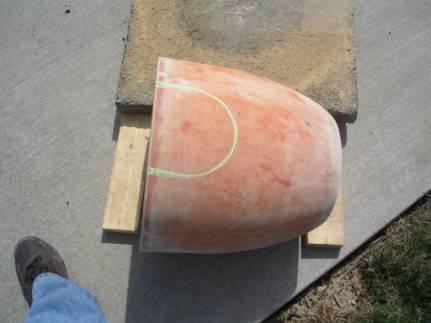
|
|
2. Cut out the opening using the saber saw. Go slowly as to not crack the pot.
|
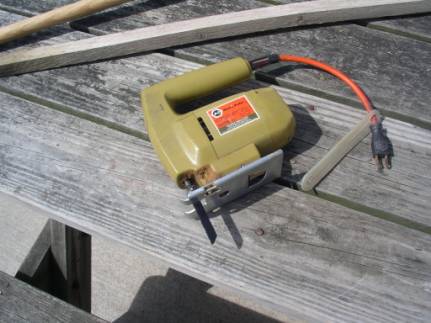
|
|
3. Place the two halves of the 2” X 4” about 2 feet
apart and place the paving block on top of them. |
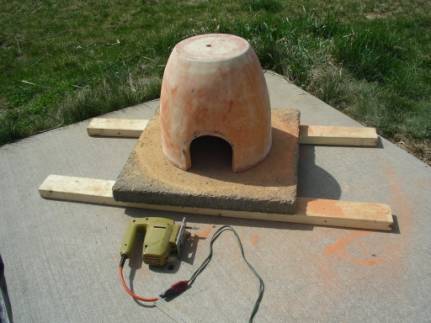
|
|
4. Place the oven top down on the paving block. YOU’VE MADE
YOUR OVEN!
|
Firing the Oven and Baking Bread
You will need:
- Child’s hoe
- Charcoal & Charcoal lighter
- Ceramic tiles (1-4” X 4” X ¼”, 1-8” X 8” X ¼”)
- Small block of wood
- Matches
- Oven thermometer (probe type appropriate for deep frying)
- Metal spatula
1. Remove
the oven from the “hearth stone” (the paving block)
and place about 50 charcoal briquets in the center of the block.
Carefully apply charcoal lighter and light the fire
|
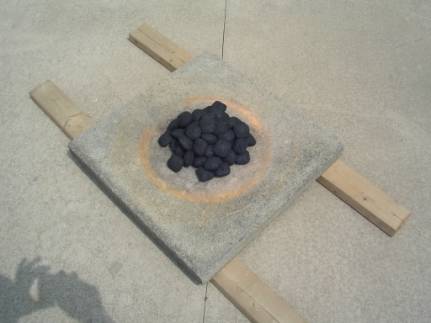
|
2. Allow
the fire to burn until no flames are present and the briquets
begin to turn gray (about 15 minutes).
Carefully place the oven over top of the briquets |
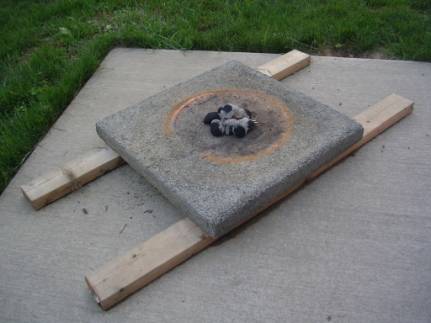 |
3. Insert
the oven thermometer through the hole in the top of the oven (what
was the bottom of the pot).
Preheat the oven to at least 375°F, preferably to 400°F.
THIS IS THE TRICKIEST PART. The oven temperature will
depend on the outside air temperature, the wind, the amount of
charcoal, and the draft moving through the oven.
The draft is controlled by placing the 8” X 8” tile
over the opening as a door and by closing down the hole in the
top using the small piece of wood. Too much draft and all you
heat escapes out of the top. Too little draft and the fire goes
out. To get the most heat out of your fire, watch the temperature
and adjust the draft. If the oven is closed up and the temperature
is dropping, you have too little draft. Try opening the hole in
the top, if it continues to drop try opening the door. If the
temperature begins to rise, you had too little draft. If it is
a cool or windy day you may need to insulate the oven (try using
an old blanket or coat). |
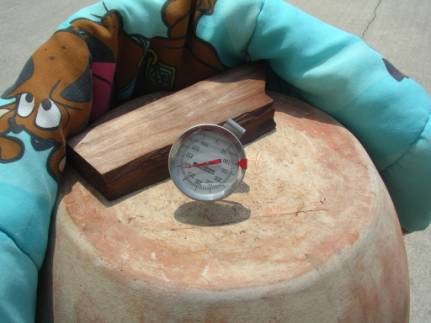 |
| 4. To
get the draft just right you may need to add spacers below the
door. This allows just enough air to be drawn into the oven at
the level of the coals where it is needed. |
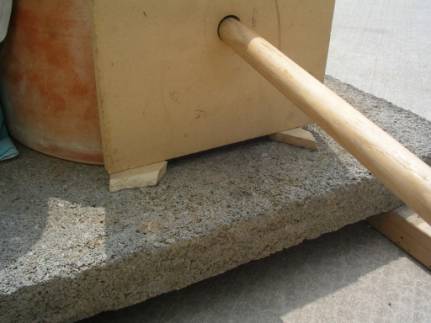 |
| 5. Open
the oven and using the hoe, move the coals to the outer edges
of the oven, leaving enough room in the middle for your bread
(about 6” X 6”). |
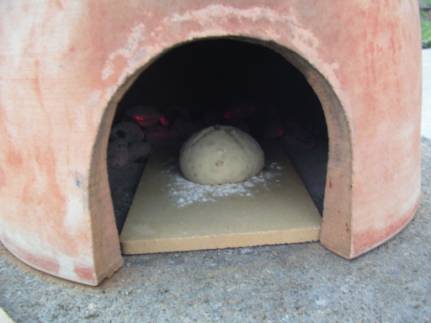 |
| 6. Place a formed loaf of bread (see below) about the size of
a baseball on a lightly floured small ceramic tile and insert
the tile into the oven. |
|
| 7. Replace the door and hold it in place with the hoe. |
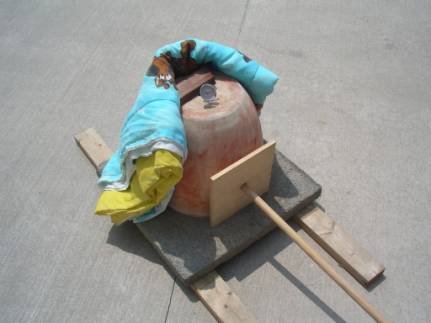 |
| 8. Bake your bread for 30-45 minutes. You may want to turn it
around one half turn about 20 minutes through the baking. The
exact time of baking will depend on the heat of you oven and the
size of your loaf of bread. |
|
| 9. Carefully
remove your bread from the oven using a metal spatula (peel). |
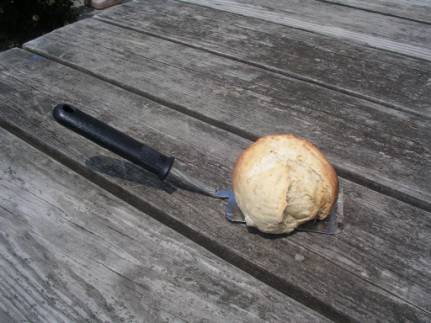 |
| 10. Allow
the bread to cool for 5-10 minutes and then EAT! |
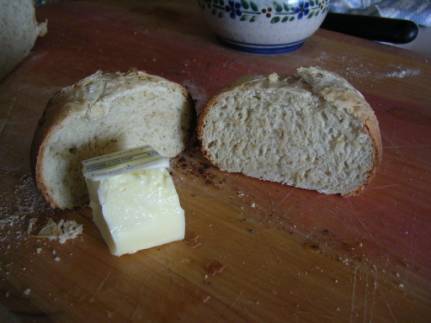 |
Problem Solving Exercises
- What three things could you do if your oven didn’t get hot
enough?
- What three things could you do if your oven were too hot?
- Why doesn’t the oven get hot immediately?
- Why were the walls of clay ovens so thick?
For further exploration
- Why were mills and ovens highly regulated in Medieval Europe?
- What was different about Colonial America that made this regulation
difficult?
- Considering how long it took to make your bread from start to finish
what portion of a colonial homemaker’s time was likely involved
in bread baking?
- What grains would have been available to the Colonists and how did
this differ from Medieval Europe?
- How would the grains affect the type of bread eaten?
Notes to the Teacher
- Most of the items you will need are available at your local home
supply center.
- It is best to site the oven where the air is still (try to avoid
windy places).
Recipe for a good loaf of oat bread
(from Bernard Clayton Jr., The Complete Book of Bread)
Each of the three loaves of this bread is about the size of an orange.
Ingredients
- 1 ½ cups of rolled oats
- 2 ½ - 3 cups all purpose flour
- 1 package dry yeast
- 2 tablespoons sugar
- 1 tablespoon salt
- 2 tablespoons butter, room temperature
- 1 ½ cups hot tap water (120-130°F)
- Topping (optional): 1 egg white
- 1 tablespoon water
- 3 tablespoons seeds (sesame or poppy seed)
|
Preparation
(15 mins.)
|
In a large mixing bowl, measure the rolled oats and 1 cup all
purpose flour and stir in yeast, sugar, salt butter and water. Beat
in an electric mixer at medium speed for 2 minutes, or for an equal
length of time with a wooden spoon. Stop the mixer. Stir in balance
of the flour, a half cup at a time, first with the spoon and then
by hand. The dough will be a rough shaggy mass that will clean the
side of the bowl. |
|
Kneading
(8 mins.) |
Turn the dough onto a lightly floured work surface – countertop
or bread board – and knead with a rhythmic 1-2-3 motion of
push-turn-fold. The dough will become smooth and elastic. Sprinkle
more flour on the dough and the work surface if the dough continues
slack and sticky. Break the kneading rhythm occasionally by throwing
the dough down hard against the countertop. Knead for 8 minutes. |
|
First Rising
(1 hour) |
Place the dough in the bowl and pat with buttered fingers to keep
the surface from crusting. Cover the bowl tightly with plastic wrap
and move to a warm place (80-85°F) until the dough has doubled
in size. You can test if it has risen by poking a finger in it;
the dent will remain. |
|
Shaping
(20 mins.) |
Turn back the plastic wrap and punch down the dough. Knead for
30 seconds to press out the large bubbles. Divide the dough into
three equal pieces and let rest for 5 minutes. Beat the egg white
and one tablespoon of water together in a cup until frothy (if seeding
bread). Sprinkle the seeds onto a plate or into a bowl. Shape each
part of the dough into a round ball, slightly flattened on top.
Hold loaf in the fingers, brush top and sides with the egg white
mixture. Invert the loaf in the seeds, pressing down lightly to
cover. Carefully place the loaf on the floured tile. With a sharp
knife, cut a cross in the top with two grooves about ½ inch
deep. |
|
Second Rising
(45 mins.) |
Place the baking sheet in a warm place and cover carefully with
a length of wax paper. The loaves will double in size. |
|
Baking
(400°F) |
Preheat the oven to 400°F. Bake the loaves in the oven until
they are golden brown. To test if they are done, turn the loaf over
and tap the bottom crust with the forefinger. A hard hollow sounds
means the bread is baked through. Don’t over bake these small
loaves. Midway in the bake period shift the loaves so they are exposed
equally to the temperature variations in the oven. |
|
Final Step |
Remove bread from the oven and allow to cool on a metal rack. |
Bibliography
- The Complete Book of Breads, Bernard Clayton Jr., Simon and Shuster, New York, 1973
- The Bread Ovens of Quebec, Lise Boily and Jean-Francois Blanchette, Natioanl Museums of Canada, Ottawa, Canada, 1979
- Six Thousand Years of Bread, H.E. Jacob, Lyons and Burford, New York, 1997
- Building Your Own Earth Oven, Kiko Denzer, Handprint Press, Blodgett, OR, 2001
- The Bread Builders, Hearth Loaves and Masonry Stoves, Daniel Wing and Alan Scott, Chelsea Green Publishing, White River Junction, VT, 1999
- The Book of Masonry Stoves, David Lyle, Chelsea Green Publishing, White River Junction, VT, 1984
|













